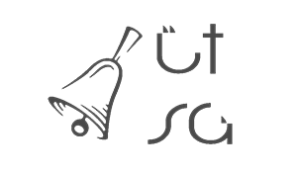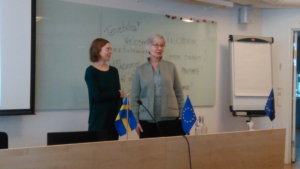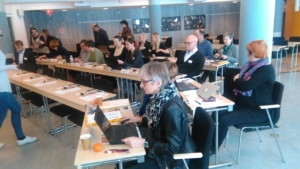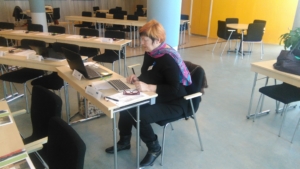Warning: Trying to access array offset on false in /data03/virt37658/domeenid/www.estodiac.eu/htdocs/estodiac/wp-content/themes/enfold/framework/php/function-set-avia-frontend.php on line 570
Sempre 18.aprill 2016 LULEA
Fuajees tudengite tehtud kunstitööd.
Tutvustus Norrbottenist. Nende visioon: Parem elu, parem tervis.
Norrbottenist lühidalt: 250,000 inimest, 2,6% kogu populatsioonist Rootsis. See on hea piirkond, et siin elada. Suhteliselt palju rahvast. Paljud töötavad kaevanduses. Samuti traditsiooniline puutöö, puidutöö. Suurim tööandja on avalik sektor. Ühes firmas üle 2000 inimese.
Neil on 5 haiglat, 30 perearstikeskust, 4 eraarstikeskust, 46 hambaarstikeskust.
Neil on 28 kiirabit. Sealt alustatakse tervise andmisega. See on vahel väike haigla. See ei ole ainult transport. Sageli kiirabi on nende esimene kontakt. Haiglas nad juba teavad probleemi, selle eeltöö põhjal.
Hambaravi on tasuta, kuni nad on 21 aastased. Vähestel lastel on hammastega probleeme.
On oluline töötada tervise edendamise, õpetamisega. Oluline on edendada e-tervist – arstiga saab ühendusse internetis.
Firma Companioni juhi tutvustus
Paar sõna meie tööst ja probleemidest sellel alal. Companionil on 24 kontorit. Aitame uusi asutusi. Neil on riigi tase, kohalik tase, maavalituse tase. Klientidelt raha ei võta. (National, regional, local level)
Nt: Noored, kes on asutustes hakanud töötama. Külad, mis võtavad poed üle.
Rõhutab, et nende probleemiks on, et noored inimesed kaovad. Kuidas arendada maapiirkonda ainult vanade inimestega?
On inimesi, kes tulevad siia, sest siin on rahulik.
Tänapäeval tulevad teisest kultuurist inimesed. Erinevad kultuurid kohtuvad. Kui see kohtumine on hea, on palju võimalusi. See on väga oluline.
Peame leidma uut tüüpi integratsiooni, mis töötaks erinevate integratsiooni vormidega.
Tahame tulla tagasi sinna, kus Läänemeri on üks üksus, et me ei oleks nii jagunenud.
Dorise sissejuhatus
Migratsioon on oluline teema ka meile. Alguses see nii oluline ei olnud, aga ajapikku kasvas see väga oluliseks. See on uus impulss, millega peame tegelema.
Kõik sihtgrupid kokkuvõtvalt: Single parents, families, migrants, people with dissabilities.
Innovatsiooni paradigmadest
Innovation paradigm shift – during the last 5-10 years.
From Development and commercialization of technological product innovations to social changes and social needs
Innovation – reduced, something new.
- New solutions – services, methods, Technologies, things etc.
- Nes needs – to acknowledge new needs
- New impact – what do we want to change
- New involvement
- New relations
- New combinations – nothing is ever radical new.
- New contexts – new context of solutions. New tärget group, new sorta probleem.
New paradigm -> new concepts
Open, user.driven, participatory, democratic, inclusive, social innovation
Innovation –
- Technological aspect
- Socioal aspects
- Service aspects
- Organizational aspects
Innovation multitute aspects and multitude degrees, levels.
Aspects are intertwined.
So why prefixes, such as social innovation
- Requiered due to the technological bias of the innovation concept
- Makes marginalized innovation actors/areas/forms visible
- enables mobilization of scattered actors/phenomena
- Highlights ohter aspects in innovations than technological ones
What is social innovation?
- Development and implementation of new solutions to societal challenges or social needs amond disadvataged groups
- Imrovement in life-quality, wellbeing, relations and empowerment
- Social imrovement on individuaal, communal, organizational and societal levels.
Rural examples of social innovation
- Local service points – co-location of public, commercial and civil services in rural ares.
- Green care – rehabilitation and health care in green industries
- Rural podcast – rural inhabitants depicting their everyday life
- Youngagement – involvement of youths in rural developmet
- Integratuon by natuure . introduction to the swedish natuure and countryside for immigrants
Inclusion and interaction in social innovation
- Involvement of disadvangaged groups;
- Interaction between groups, networks, organizations, areas, sectors;
- the identification of social needs and in the development of solutions.
Empowerment by social innovation
- A process from social exclusion to social inclusion.
- Requieres redistribution of resources (knowledge, counselling, legitimacy, contacts, finances etc.)
- Requires transformation of patterns and preconceptions regarding gender, ethnicity, class, rurality etc.
- Normatiive assessment of relevant needs and desirable change among disadvantaged groups.
- Empowerment on individuaal and structural levels
Rural empowerment by social innovation
- Innovative solutions for reliable, affordable and accessible infrastructure for social services in rural areas
- Increasind life chances and expoiting potentials among disatvantage groups in rur
- Connecting users and providers of rural social services for identification of real needs inspiring innovative solutions.
- Linking public authoroties or ohter well-resourced organizations with less resourceful, but socially innovative, civil society actors.
The next challange Gendered social innovation
- Identification of societal challenges and social needs of gender /in)equality various societal areas.
- Development of solutions by inclusion of women or men as disadvantaged groups in the focused area.
- Transformation of gendered patterns and preconceptions on individuaal, relational, symbolical and structural levels.
- European commisiion 2013, guide to social innovation. Brussels.




